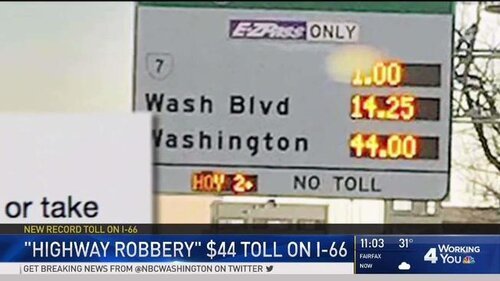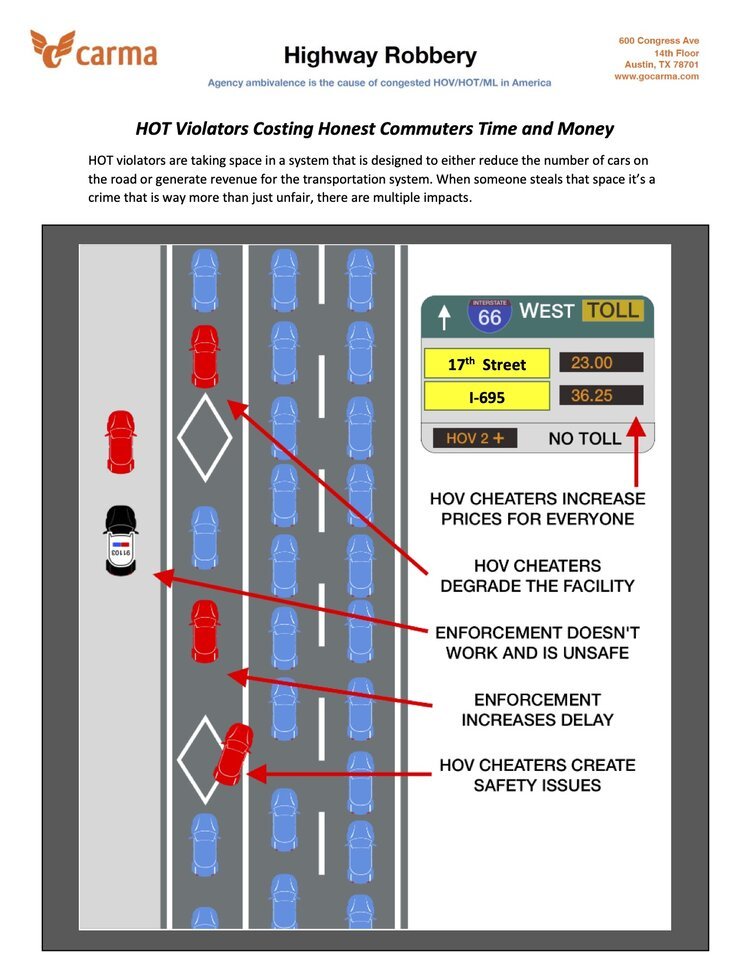Highway Robbery
October 28, 2019
Cheaters Are Congesting And Breaking Down Express Lanes–Yet Many Agencies Fail To Address The Underlying Issue
AN OP-ED ON WHAT IS TAKING THE EXPRESS OUT OF EXPRESS LANES - AND HOW TO FIX IT
In December of 2017, the Virginia Department of Transportation (VDOT) converted a9-mile stretch of Interstate-66 from a high-occupancy vehicle (HOV) only road into ahigh-occupancy toll (HOT) road, allowing commuters to pay for the use of the highway during peak periods. Throughout the process, VDOT staff informed policymakers that they expected the dynamically priced road to reach between $8-$12 dollars during those peak periods (Source 1).
Image: www.NBCwashington.com
Chaos and public outcry transpired in the first few days of the conversion as tolls spiked to over $40 (Source 2). Immediately politicians began to call for the tolls to be capped, changed, or suspended entirely. The public hysteria caused by the price spike turned this project into a political punching bag, putting plans for additional pricing programs in danger (Source 3).
So, what happened here? Was this a case of VDOT being unprepared for the demand? Were the pricing algorithms designed to keep the road moving developed incorrectly? The real answer as to what caused this drastic toll spike is simple; it was a case of highway robbery. VDOT miscalculated the number of people who were violating HOV rules before opening the HOT lane. Upon opening the HOT lanes on December 4th, thousands of drivers who had been cheating the HOV rules were now flooding the HOT lanes, causing prices to inflate beyond expectations.
HOW BAD ARE VIOLATION RATES?
Data on HOV cheaters is hard to find for several reasons. Most agencies do not release this information due to the severity of the problem, while others do not measure violations consistently. The data paints a bleak picture with more than 30%of vehicles on average violating HOV rules on HOV, HOT, and managed lanes (ML ) nationwide (Source 4).
A 2017 article cited Los Angeles transportation officials stating a 25% violation rate, causing Martin Wachs, a professor emeritus of urban planning at UCLA’s Luskin School of Public Affairs to say, “It’s a threat to the validity of the whole program. You can’t charge people to use a system that you’re not willing to enforce.” (Source 5)
Recognizing that it only takes 3-5% in additional traffic to congest a road, it’s clear to see why HOV violators are clogging HOV/HOT/ML lanes reducing their effectiveness and making them more expensive for the general public.
EXPRESS LANES REQUIRE INTEGRITY
The purpose of HOV lanes is to create an incentive for users to share a trip and reduce the number of vehicles driving on the system. Rewarding users with a faster and more dependable trip in return for taking cars off the road by pooling. HOT lanes provide users with an option to ‘buy’ into those lanes. In a sense, agencies sell vacant space. In a variable priced lane, fundamental laws of product and demand dictate the price of that faster and more dependable trip. When demand for the faster and more dependable trip goes up, so too does the price.
The price fluctuation is intended to maintain the speed and dependability of the lane. If agencies price the lane too low users will flood the system and degrade its throughput performance. Maintaining a fast and dependable speed is such an essential point that Congress has passed a law requiring that HOT lanes maintain absolute dependability and speed.
“It’s a threat to the validity of the whole program. You can’t charge people to use a system that you’re not willing to enforce.”
HOT LANE VIOLATORS COST HONEST COMMUTERS TIME AND MONEY
Violators in the HOV and HOT lanes are taking space in a system that is designed to reduce the number of cars on the road or generate revenue for the transportation system. When someone steals that space, it is a crime that is way more than just unfair - there are multiple impacts.
HOV cheaters increase toll prices for everyone – The space in these lanes is for paying customers and those who share rides which helps the entire network. When a cheater takes up space on a priced road, it causes thereto be less space for other cars;therefore, it drives the price of the remaining space to become more expensive. Nothing captures this better than our discussion on Virginia when initially the lanes were filled with violators causing fares to exceed $40.Once HOV violators were forced to pay the toll rates (because they didn’t have a flexpass) they changed their habits, took other routes, vehicle volumes decreased, and prices returned to anticipated levels (Source 6).
HOV cheaters create congestion – When cheaters use an HOV/HOT/ML, they degrade not only the HOV/HOT/ML lanes, but the whole network in general. Speed and dependability are the reasons why people use HOV/HOT/ML lanes.
There is value to the public when people choose to carpool or pay to use HOV/HOT/ML lanes. Those who carpool are taking cars off of the road, thus reducing congestion on the general purpose lanes. Those who pay for access to HOV/HOT/ML lanes are helping to fund and finance improvements to the transportation network in return for a faster and more dependable trip.
HOV cheaters neither pay into the system nor do they contribute to general congestion relief. When HOV/HOT/ML lanes become overburdened with cheaters they become congested and degraded. The congestion caused by cheaters eliminates the benefits to those who have chosen to carpool or pay into the lanes. So when cheaters overwhelm HOV/HOT/ML lanes they not only congest the HOV/HOT/ML lanes by reducing speeds and eliminating dependability, they also impact general purpose lanes as users will discontinue carpooling and paying for access to the HOV/HOT/ML lanes.
HOV Cheating is a Safety Issue – Current enforcement is dependent upon police officers visually identifying cheaters and pulling them over to issue a citation. This type of enforcement puts lives in danger. First, the flashing lights of police instantly create a safety issue as drivers become distracted. Police activity not only creates a safety issue but also reduces the effectiveness of the system as drivers slow down to check out the action. Additionally, shoulders on many HOV/HOT/ML lanes are narrow, and pulling over a vehicle creates a safety concern for the driver, the police officer, and oncoming traffic.
The driver trying to evade enforcement is also a safety issue; pulling into and out of lanes that have different speeds creates safety issues. As drivers quickly dart in and out spaces, even the slightest error will result in an accident that can snarl all lanes of traffic.
AMBIVALENCE IS NOT THE ANSWER - NEITHER IS ENFORCEMENT
Most agencies have shown to be ambivalent about HOV/HOT/ML cheat rates, and this is evident in the fact that many agencies do not even measure their violation rates. Why? The impact of HOV cheaters is far more than a case of what is fair or unfair, HOV violators steal taxpayer dollars and cause law-abiding drivers to pay more and move slower. As more agencies look to pricing as a congestion relief strategy we need to challenge operational leaders to address HOV violations.
Unfortunately, most agencies rely on police enforcement to address HOV violators because it’s an easy answer. Simply put, visual enforcement by law enforcement officers is not safe, doesn’t work, and degrades the system by creating more congestion.
“If one of our stores had a shoplifting rate of 20%-30%, then I would terminate the manager, and initiate an investigation. And if all my stores experienced 20%-30% shoplifting rates, then I would be fired and we would be out of business.”
Police cannot pull over enough vehicles to make enforcement work – On average, a police officer can cite between 2-4 drivers and hour for HOV violations. Considering that about 1600-2400 cars can travel on a congested lane per hour (Source 7), catching less than 2% of all violators in an enforcement raid involving ten officers.
Police enforcement is not a deterrent – One of the prevalent theories is that enforcement would serve as a deterrent, but a study conducted by the Virginia Transportation Research Council found that police enforcement was not a deterrent, and following high enforcement periods violation rates actually increased (Source 8).
Verify Occupancy To Restore Fairness
Technology is changing everything, yet we still manage and enforce our roads the same way we did thirty years ago. Agencies should move past the ‘catch me if you can’ philosophy of HOV enforcement and move towards verifying occupancy before any discount or rebate can be applied. There are two categories of enforcement - automated and manual.
Manual verification includes law enforcement officers, pre-declaration smartphone apps, and carpool permitting systems. None of these methods reduces violation rages, and all of them create a safety hazard and perpetuate the problem.
Automated Vehicle Occupancy Detection AVOD is the only safe way to address the problem, and the two types of solutions include camera systems or post-trip fraud verification like the GoCarma Occupancy Verification system. Automated solutions are the safest and most reliable solution that does requires ZERO interaction by law enforcement or commuters at anytime (before, during or after a trip).
Camera systems – Camera systems have yet to be shown to be effective. While accuracy rates are improving, multiple pilots have demonstrated that they are not accurate enough, are cost prohibitive, and create privacy issues. Some states have even banned these types of technologies.
Carma Technology - once installed GoCarma automatically tracks the occupancy of a vehicle using non-trackable BLE technology... without any user interaction. This occupancy count can be used to qualify for HOT/HOV/EL discounts, HOV lane lane access, and travel behavior rewards. This technology has been used inside dozens of apps for more than a decade while tracking more than a billion user trips across public transportation, carpools, car sharing and autonomous vehicles (learn more at https://www.gocarma.com/)
SOURCES
Source 1 - http://www.novatransit.org/uploads/meetings/2018/Dec2018handouts.pdf
Source 2 - https://wtop.com/dc-transit/2017/12/dynamic-tolls-66-climb-36/
Source 3 - https://www.insidenova.com/news/transportation/legislators-want-i--tolls-suspended-vdot-defends-toll-prices/article_f81c91e0-dc1c-11e7-b5a9-173e01df1740.html
Source 4 - https://sacramento.cbslocal.com/2019/03/25/drivers-cheating-carpool-lane/
Source 5 - https://www.latimes.com/local/lanow/la-me-ln-toll-lane-cheating-20170929-story.html
Source 6 - http://inside.transform66.org/documents/news/12-12-17-first_week_updatecp.pdf
Source 7 - Guide to Traffic Management Part 3: Traffic Studies and Analysis.Austroads. 2013. pp. Section 4
Source 8 - http://www.virginiadot.org/vtrc/main/online_reports/pdf/10-cr1.pdf



